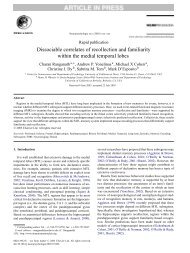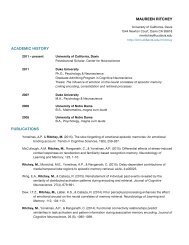<strong>CLINICAL</strong> <strong>EEG</strong> <strong>and</strong> <strong>NEUROSCIENCE</strong> ©2007 VOL. 38 NO. 1P600, are modulated by repetition of meaningful stimulisuch as words <strong>and</strong> pictures. The effect of repetition on theN400 is much like the effect of a congruous semantic context:Repeated stimuli normally elicit a smaller negativitythan novel stimuli, or may eliminate the N400 componententirely. The P600 (or late positive component, LPC) is apositivity that peaks ~600 ms after the presentation ofmeaningful stimuli (e.g., words, pictures). Its scalp distributionis similar to that of the P300 elicited by simple tones orshapes — a midline parietal maximum, slightly greaterover the left hemisphere, 51 but the P600 peaks later <strong>and</strong> iselicited by more complex stimuli. Depth recordings in presurgicalepilepsy patients have found P600-like waveformsgenerated in the hippocampus, entorhinal cortex, <strong>and</strong> severalother paralimbic cortices (i.e., cingulate, temporalpole, orbitofrontal cortex 34 ).In word-list memory experiments, the P600 appears toindex verbal episodic memory processes: Larger amplitudeis found on initial exposure to words that are deeply encoded52,53 or subsequently remembered, 54 <strong>and</strong> on repeatedexposure for words correctly identified as “old”. 55 However,words presented in a coherent semantic context (ratherthan a r<strong>and</strong>omized list) have the opposite effect on theP600, producing smaller amplitudes for repeated relativeto initial presentations. The bivalence of these two congruityeffects was reconciled in a model proposed by VanPetten et al 51 in which the P600 reflects the updating ofworking memory with the contents of long term memory. Ina coherent context, semantically predictable words aremore likely to be in working memory at the time of repeatedexposure, obviating the need for updating workingmemory <strong>and</strong> reducing P600 amplitude.In word-repetition studies, it is often difficult to dissociatethe contributions of N400 <strong>and</strong> P600 to the overall repetitioneffect because the components occupy partiallyoverlapping latency ranges, <strong>and</strong> the effect of repetitionmay be the same on both (i.e., decreased negativity ofN400 <strong>and</strong> increased positivity of P600). Therefore, wordrepetitioneffects are typically expressed as an averagepotential over a time window that spans both components.A few studies that have attempted to dissociate N400 <strong>and</strong>P600 repetition effects are discussed later.N400/P600: repetition effects in temporal lobe epilepsyOne research group has reported several intracranial<strong>EEG</strong>/ERP studies of pre-operative patients with temporallobe epilepsy. 56,57 Grunwald et al 56 found a negative componentin the anterior hippocampus, peaking at ~440 mspost-stimulus (referred to as early negativity for words, orENw), that showed a positive shift in response to repeatedwords (continuous old/new task, lag range: 2-18 items).The ENw was smaller on the side of the epileptogenicfocus (subsequently replicated by Helmstaedter et al 57 ). Inaddition to the ENw, Grunwald et al found a late negativity(LNw) in response to repeated words (virtually flat for initialpresentation) in the posterior hippocampus, peaking at~790 ms, which was also smaller ipsilateral to the focus.Further analyses showed that the LNw was apparent onlyfor repeated words that were correctly responded to as“old,” <strong>and</strong> not for unrecognized old words, following thepattern of the scalp-recorded P600 in normal participants.Smith <strong>and</strong> Halgren 58used an ERP word-list memoryparadigm to study epilepsy patients after unilateral temporallobectomy (average repetition lag: 19 items or 50 seconds).Patients with right anterior temporal lobectomyshowed a robust positivity between 250 <strong>and</strong> 650 ms followingold relative to new items; however, left anterior temporallobectomy patients showed a reduced repetition eff e c t .Using a continuous old/new word judgment task with a relativelyshort repetition lag (6 items), Rugg et al 10f o u n ddiminished (not significantly different from zero) ERP r e p e-tition effects in both left <strong>and</strong> right temporal lobectomypatients. In pre-surgical temporal lobe epilepsy patients,E R P repetition effects were intact over midline electrodesbut reduced over the hemisphere ipsilateral to the seizurefocus. Interestingly, when repetition was incidental to thetask (lexical decision), <strong>and</strong> when some words were repeatedimmediately (lag of 0 items), Rugg et al found significantrepetition positivity in all patient groups. This pattern ofresults suggests that, while lesions of anteromedial temporallobe structures may disrupt ERP word repetition eff e c t sthat are dependent upon intact consolidation processes, notall ERP word repetition effects are generated by this region.N400/P600: repetition effects in amnesiaIn a picture-list memory task (line drawings of commonobjects; average repetition lag: 5 items or 20 seconds),Mecklinger et al 59 found no old/new ERP e ffects in patientswith amnesia due to chronic hypoxia, despite above-chance(but impaired) performance on the recognition task. T h eauthors suggest that recognition performance in amnesiamay be supported by a relatively preserved implicit memoryprocess, but that the ERP measure was not sensitive tothis process. Another interesting dissociation, an ERP e ff e c tfor unrecognized items, was found by Lalouschek et al 60 i na study of a single patient with amnesia due to an aneurysmof the anterior cerebral artery. In that study, ERPs for itemsresponded to as “new” were more negative if the “new”response was incorrect (i.e., unrecognized old items) than ifthe response was correct (i.e., correctly rejected new items)in a very late time window (900-1200 ms) over inferotemporalchannels. Note that Cz was used as a reference in thisstudy; therefore, these results are consistent with increasedpositivity over central channels if a linked mastoid or earlobereference had been employed (as in the majority ofstudies reviewed here).Work in the authors’ laboratory has attempted to isolatescalp-recorded N400 <strong>and</strong> P600 effects in amnesia byadding a semantic congruity manipulation to a word-repetitionparadigm. 2 In this procedure, a category statement12
<strong>CLINICAL</strong> <strong>EEG</strong> <strong>and</strong> <strong>NEUROSCIENCE</strong> ©2007 VOL. 38 NO. 1Figure 1.Gr<strong>and</strong> average waveformsfor congruous words (initial<strong>and</strong> repeated presentations)for normal elderly(n=12), amnesic (n=12),Mild Cognitive Impairment(n=14; mean MMSE=27)<strong>and</strong> mild AD (n=11; meanMMSE=24) groups. TheP600 is indicated in thenormal group waveforms.The congruous repetitioneffect (due to a diminishedP600 to repeated words) isshaded between 300-800ms where present.was spoken (e.g., “A type of wood”) followed by the visualpresentation of a target word (e.g., “cedar”; equal numbersof congruous <strong>and</strong> incongruous trials were presented) <strong>and</strong>participants were required to read the target word <strong>and</strong> verballyindicate whether it belongs to the preceding category.Category statement-target pairs were repeated once (lag:0-3 trials or 10-40 sec later) or twice (lag for each repetition:10-13 items or about 120 sec). This allowed for analysisof N400 congruity effects (initial congruous vs. initialincongruous trials), N400/P600 repetition effects in theabsence of a coherent semantic context (repeated incongruousvs. initial incongruous), <strong>and</strong> isolated P600 repetitioneffects (repeated congruous vs. initial congruous). Thislast comparison allowed for isolation of the P600 becausethe congruity of the category statement <strong>and</strong> the targetessentially eliminated the N400. Amnesic patients showeda significant N400 congruity effect (latency window: 300-500 ms), <strong>and</strong> a significant N400 repetition effect for incongruoustargets, but no P600 effect for repeated congruoustargets (this effect was robust in normal controls from 500-800 ms; see Figure 1).Olichney et al 2 found no correlation between the amplitudesof the N400 <strong>and</strong> P600 repetition effects within theamnesic patient group, supporting the notion that thesetwo components index different cognitive <strong>and</strong> neuralprocesses. Furthermore, the magnitude of the P600 (butnot the N400) repetition effect correlated with neuropsychologicalmeasures of the patients’ verbal memory ability<strong>and</strong> with subsequent cued-recall performance for the presentedstimuli. This work suggests that the N400 is intactin patients with well-circumscribed amnesia, showing bothsemantic congruency <strong>and</strong> repetition effects. Furthermore,the size of their N400 repetition effect showed no relationto explicit memory performance. Thus, the N400 may be aneural correlate of amnesics’ preserved implicit memoryprocesses as observed in conceptual priming tasks. 1 Thediminished P600 repetition effect in amnesia <strong>and</strong> its correlationwith explicit memory performance are consistent withthe interpretation of the P600 as reflecting the updating ofworking memory with the contents of long term memory. Inamnesic patients, this updating was evidently necessaryfor both the new <strong>and</strong> old congruous stimuli.N400/P600: repetition effects in Alzheimer’s diseaseThe neuropathology of AD affects the medial temporallobes early in the course of the disease, <strong>and</strong> deficits ofepisodic memory are usually the earliest presenting symptom.Therefore, one might expect ERP word-repetitione ffects in AD to resemble those of medial-temporalamnesics. However, studies of ERP word-repetition effectsin AD have produced a complex pattern of results.Using a continuous semantic judgment task (buttonpressrequired for “animal” names) with incidental repetitionof non-targets (“non-animal” words were repeated;average lag: 30 sec) in AD, Friedman et al 61 reported preservedlate (700-1000 ms) repetition effects in most (6 of10) mild AD patients. The authors attributed the residualrepetition effects to relatively preserved implicit memoryprocesses in AD. Rugg et al 62 used a similar continuoustask with incidental repetition at somewhat shorter lags(average: 6-21 sec) <strong>and</strong> found ERP repetition effects (300-400 <strong>and</strong> 400-700 ms) in AD that were statistically indistinguishablefrom those in controls, although a trend for asmaller repetition effect with longer lags was noted.In contrast, Tendolkar et al 6 3 employed an explicit wordlistmemory task <strong>and</strong> a longer inter-item lag (~5 minutes) <strong>and</strong>found very different results. In that study, controls exhibiteda large repetition positivity for correctly recognized old itemsin both early (300-600 ms) <strong>and</strong> late (700-900 ms) latencywindows. This effect was further enhanced for items forwhich source memory was also correctly retrieved (wordshad been displayed in one of two colors) from 600-900 ms,supporting an association between late positivity (P600) <strong>and</strong>conscious retrieval processes. In AD patients, no repetitione ffect was present in the late time window, <strong>and</strong> an effect in13




